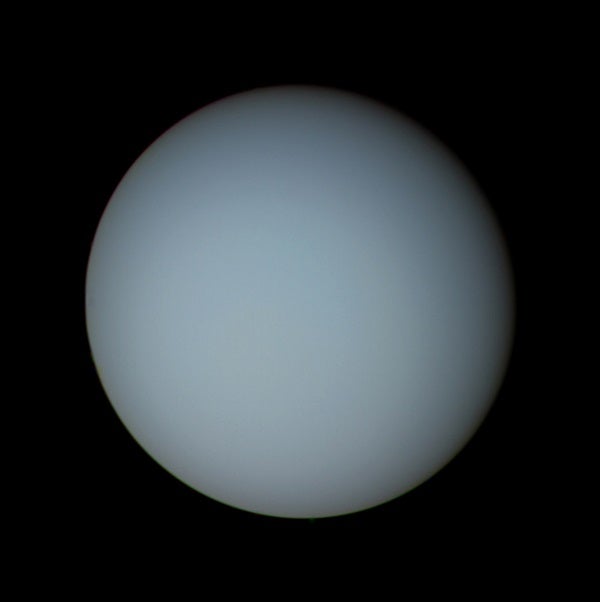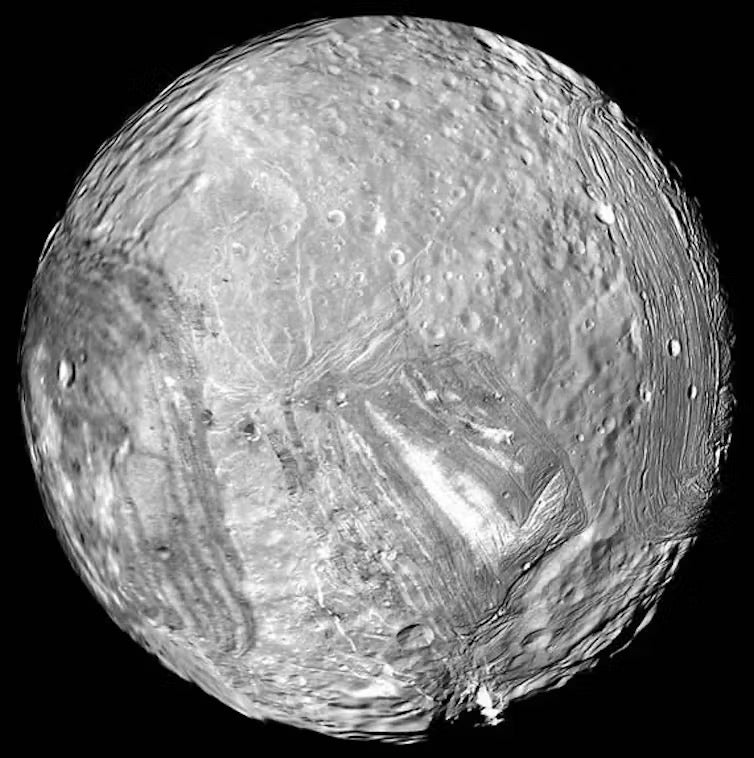
Blue-green Uranus may not look like much through a telescope, but you can see its small disk at magnifications of 100x and more. Even this close-up look from the Voyager 2 spacecraft fails to reveal much detail. Credit: NASA/JPL.
Uranus, the seventh planet from the Sun, orbits in the outer solar system, about two billion miles (3.2 billion kilometers) from Earth. It is an enormous world – quadruple the diameter of Earth, with 15 times the mass and 63 times the volume.
Unvisited by spacecraft for more than 35 years, Uranus inhabits one of the least explored regions of our solar system. Although scientists have learned some things about it from telescopic observations and theoretical work since the Voyager 2 flyby in 1986, the planet remains an enigma.
It’s easy to divide the solar system into two large groups: an inner zone with four rocky planets and an outer zone with four giant planets. But nature is, as usual, more complicated. Uranus and Neptune, the eighth planet from the Sun, are vastly different from the others. Both are ice giants, composed largely of compounds such as water, ice, ammonia and methane; they are places where the average temperature is minus 320 to minus 350 degrees Fahrenheit (minus 212 Celsius).
Through recent discoveries of exoplanets – worlds outside our solar system that are trillions of miles away – astronomers have learned that ice giants are common throughout the galaxy. They challenge our understanding of planetary formation and evolution. Uranus, comparatively close to us, is our cornerstone for learning about them.
A new mission
Many in the space community – like me – are urging NASA to launch a robotic spacecraft to explore Uranus. Indeed, the 2023 decadal survey of planetary scientists ranked such a journey as the single highest priority for a new NASA flagship mission.
This time, the spacecraft would not simply fly by Uranus on its way somewhere else, as Voyager 2 did. Instead, the probe would spend years orbiting and studying the planet, its 27 moons and its 13 rings.
You may wonder, why send a spacecraft to Uranus and not Neptune. It’s a matter of orbital architecture. Because of the positions of both planets over the next two decades, a spacecraft from Earth will have an easier trajectory to follow to reach Uranus than Neptune. Launched at the right time, the orbiter would arrive at Uranus in about 12 years.
Here are just a few of the basic questions a Uranus orbiter would help answer: What, exactly, is Uranus made of? Why is Uranus tilted on its side, with its poles pointed almost directly toward the Sun during summer – which is different from all the other planets in the solar system? What is generating Uranus’ strange magnetic field, shaped differently than Earth’s and misaligned with the direction the planet spins? How does atmospheric circulation work on an ice giant? What do the answers to all these questions tell us about how ice giants form?
Notwithstanding the progress scientists have made on these and other questions since the Voyager 2 flyby, there’s no substitute for direct, close-up and repeated observations from an orbiting spacecraft.
The rings and those moons
The rings around Uranus, probably made of dirty ice, are thinner and darker than those around Saturn. A Uranus orbiter would look for “ripples” in them, akin to waves on a lake. Finding them would let scientists use the rings as a giant seismometer to help us learn about the interior of Uranus, one of its great secrets.
The moons, mostly named after literary characters from the writings of Shakespeare and Pope, are primarily made of frozen mixes of ice and rock. Five of the moons are particularly compelling. Miranda, Ariel, Umbriel, Titania and Oberon are all big enough to be spherical and treated as miniature worlds in their own right.
During its flyby, Voyager 2 took low-resolution images of the moons’ southern hemispheres. (Their northern hemispheres, still unseen, remain one of the major unexplored frontiers of our solar system.) Those images include photos of ice volcanoes on Ariel – a tantalizing hint of past geological and tectonic activity and, possibly, subsurface water.
The possibility of oceans and life

A cratered world of varied landscapes, Miranda is a Uranus moon that might be an ocean world. Credit: NASA/JPL-Caltech
Which leads to one of the most exciting parts of the mission: Many planetary scientists theorize that Ariel, and perhaps most or all of the other five moons, may be an ocean world harboring large, underground bodies of liquid water miles beneath the solid, icy surface. Finding out whether any of the moons have oceans is one of the major goals of the mission.
This is one reason why an orbiter would probably carry a magnetometer – to detect the electromagnetic interactions of an underground ocean as one of its moons travels through Uranus’ magnetic field. Instruments to measure the moons’ gravitational fields and cameras to study their surface geology would help, too.
Liquid water is an essential requirement for life as we know it. If oceans are detected, scientists will then want to look for other ingredients for life on the moons – such as energy, nutrients and organic matter.
Not a done deal
No launch date has been set for the mission, and there’s not yet an official go-ahead from NASA on its funding. The cost would probably be more than a billion dollars.
One critical factor to consider: The cosmos operates on its own timetable, and those spacecraft trajectories to Uranus will change over the years as the planets move along their orbits. Ideally, NASA would launch a mission in 2031 or 2032 to maximize trajectory convenience and minimize travel time. That time span is less than it may seem; it takes years of planning – and years more of constructing the spacecraft – to be ready for launch. That’s why the time is now to start the process and fund a mission to this fascinating world.
Mike Sori is an assistant professor of planetary science at Purdue University.
This article first appeared on The Conversation. You can read the original here.





